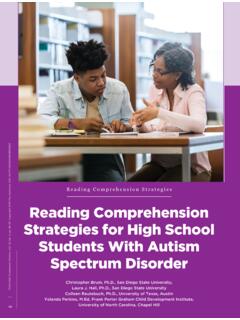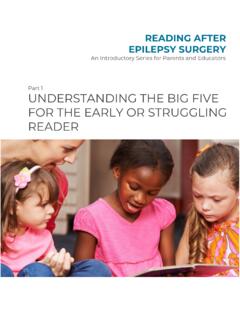Transcription of The ‘Big Six’ components of reading - Black Forest Primary …
1 Learning to read is one of the most important educational outcomes of Primary education. The ability to read is fundamental to children s learning, including their development of broader literacy skills, and to their future successful participation in society, including the workforce. reading is a complex process that involves both learning to decode texts and learning to make meaning from texts. In 2000, the US National Institute of Child Health and Human Development (NICHD) were tasked with convening a National reading Panel (NRP) to review evidence-based research into approaches to teaching committee identified five components essential to reading instruction: phonological awareness phonics vocabulary fluency comprehension (National reading Panel, 2000). These align closely with the findings of the National Inquiry into the Teaching of Literacy (DEST, 2005), chaired by Dr Ken Rowe, and equally supported by the UK Government s Final Report into the Teaching of Early reading (Rose, 2006).
2 A sixth component oral language has been added to these original five, to reflect the range of research emphasising the importance of oral language development to the reading process (Konza, 2011, 2014). Oral language provides the foundation for learning to read, and is related to overall reading achievement throughout Primary and secondary schooling (Snow et al, 1998; Wise et al, 2007).The Big Six To be effective readers children need to be able to use the six components in combination. An integrated approach to explicit reading instruction is therefore essential to provide relevant learning connected to other experiences. While teachers may highlight individual components at different times, they are not a set of isolated skills and need to be integrated throughout reading opportunities across the day. So, for example, while the systematic teaching of phonics is an important component, it is not sufficient in itself for learning to read. An integrated approach to explicit reading instruction.
3 Is essential to provide relevant learning connected to other Big Six 1 components of readingDEPARTMENT FOR EDUCATION AND CHILD | BEST ADVICE | LEADING LEARNING IMPROVEMENTLITERACY | The Big Six components of reading | awarenessOral languageThe Big Six of reading1 The term, the Big Six , was first coined in relation to reading by Deslea Konza, and has since gained major currency through the Australian Primary Principals Association, Principals as Literacy Leaders Program from 2009 and in subsequent publications by Dr Konza and other languageIt is impossible to understand the written form of a language without a wide vocabulary and familiarity with language structures. These are, in most cases, already well developed before a child begins school (Reese, Sparks & Leyva, 2010; Skeat et al, 2010), Oral language therefore provides the foundation for learning to read and is directly linked to overall reading achievement. When children are surrounded by, and included in, increasingly complex conversations they: expand their vocabulary increase the complexity of the language structures they use become language risk-takers develop confidence in the way they communicate clarify their thinking and deepen their understanding of their world tune into the sounds of standard Australian English awarenessPhonological awareness refers to the ability to focus on the sounds of speech: it encompasses an awareness of rhythm, rhyme, sounds and syllables.
4 Awareness often begins with rhythm, for example, children clapping the beats of their name. The next step is often rhyme: producing rhyming patterns like king, wing and sing demonstrates early phonemic awareness, which is the most important subset of phonological awareness in the development of reading and spelling. It enables children to identify and focus on the separate sounds in words: phonemes. Children then learn to divide syllables into separate sounds and manipulate them to form different words. Letter-sound relationships can then be introduced and children can be taught phonemic and phonics skills simultaneously from this involves recognising the relationship between letters and sounds, sometimes called the alphabetic principle . Current empirical evidence supports teaching beginning and struggling readers using a synthetic approach to phonics (Johnston & Watson, 2003; Rose, 2006). This approach teaches single letters and common letter combinations in a discrete, systematic and explicit way.
5 The order in which they are taught facilitates their blending into simple words so that children can immediately practice their new skills, building automaticity and confidence. The research also recommends that these new skills are reinforced as early as possible by having children both listening to high quality texts and reading connected text themselves. Explicit phonics instruction is essential for most beginning and all struggling readers, but should always be combined with the many other elements of an effective reading program, such as rich oral language instruction, and modelled and guided reading (Konza, 2011).Phonics instruction doesn t help children understand irregular sight words such as said, was and saw. These words must be learned through rapid word recognition to the point of automaticity. For this reason, sight words are taught systematically and explicitly, rather than being addressed only when children encounter these words in texts. Comprehension is supported when plenty of practice is provided to use these newly learned sight words in context.
6 When a reader is able to immediately recognise some words accurately, they can concentrate on the new or less familiar words and focus on making meaning, rather than just children know the meaning of a word, they are far more likely to be able to read it and make sense of it within a text. Children need to be continually expanding the range of words that they can understand and use in context. Vocabulary development is both an outcome of comprehension and a precursor to it, with word meanings making up as much as 70 90% of comprehension (Bromley, 2007).Vocabulary is, for the most part, learned through repeated exposure to new words in conversations, by listening to stories, by reading , and through different media (Senechal, 1997). Exposure to words in meaningful contexts helps to make meanings clear and children can then easily add them to their word bank. This type of indirect vocabulary acquisition is particularly effective for children who arrive at school having been exposed to a wide and rich vocabulary.
7 For other children who have a more restricted vocabulary (Biemuller, 2009), and have less access to the vocabulary of books, the explicit teaching of vocabulary is essential (Beck & McKeown, 2007).LITERACY | The Big Six components of reading | FOR EDUCATION AND CHILD DEVELOPMENT2kingwingsingFluencyFluency is not the ability to just read quickly! Fluent reading is the ability to make reading sound like spoken language: it is reading with appropriate phrasing, expression and pace. Fluent readers understand and make meaning of the text as they read. Core components include accuracy, pace and expression, and volume. There is a strong correlation between fluency and comprehension. Even highly competent readers will not be fluent when the text contains many unfamiliar or technical words that are new to the reader. Fluency demands that the text be at the reader s independent reading level. This is why beginning and struggling readers need simple texts at their independent level to build speed and confidence.
8 When children are sent home with books that they can already read , they have opportunities to develop appropriate expression, to practise chunking and pausing, and, most importantly, to build their confidence. On the other hand, reading quickly without attending to punctuation, expression and comprehension is not fluency: reading rates should not be at the expense of readers understand the purpose of their reading and adjust their reading behaviours (skimming, scanning or reading closely for detail) according to that purpose. They learn that texts look different according to their identified purpose, context and audience. Readers understanding of the features of different text types helps them make meaning. Proficient readers monitor their understanding as they read, integrating new information with existing knowledge and experience. They focus on relevant parts of the text to distinguish important content from minor detail. They make and monitor predictions and evaluate content as they read.
9 For this to happen, they learn to adjust their reading strategies, pace and vocabulary knowledge, as well as their strategies for decoding and chunking to read the unfamiliar. Comprehension is made up of a toolkit of strategies that should be explicitly taught, namely:Predicting and activating prior knowledgeQuestioningVisualisingMonitorin g and clarifying Making connectionsInferringDetermining importance Summarising and synthesisingThese strategies are often intertwined but some are more suited to specific reading tasks than for learning that involves:Teachers as powerful role modelsWhen teachers enthusiastically share and talk about texts, they inspire children to become hooked on books . When children hear fluent, phrased and expressive reading , they: develop and enrich their vocabulary hear how fluent reading sounds focus on the meaning of the text hear alliteration, rhyme and word play experience the joy of listening to a intentionallyWhen reading is integrated throughout the daily program, intentional teaching may take place, either on an individual basis through 1:1 conferencing, or through a Running Record, or during shared and guided reading teacher s role is to respond to each individual reader s learning needs and to direct the next step.
10 An effective approach includes using knowledge of the reading process to gather evidence and | The Big Six components of reading | FOR EDUCATION AND CHILD DEVELOPMENT3 How can leaders support their staff?Reflective questions for leaders to ask their teachersLooking at and discussing the reading program, you could, for example, ask the teacher: How do you ensure a balance of the Big Six components in your teaching of reading ? How do you provide opportunities for reading across the school day? What differences do you notice in the range of reading behaviours in your classroom? What strategies could you use to enable learners to become more confident, successful readers? What are the next steps you could take to challenge and extend readers? How do you provide access and opportunities for learners to engage with texts that are interesting, exciting and relevant? Is there a balance of print and electronic resources? How often do you model your thinking aloud to demonstrate independent reading to your students?







